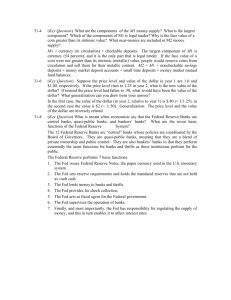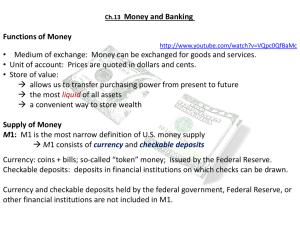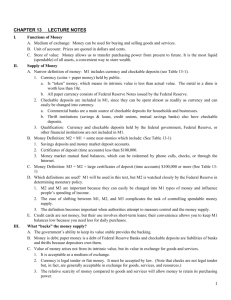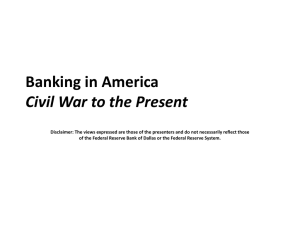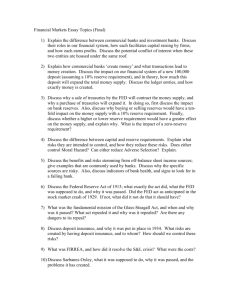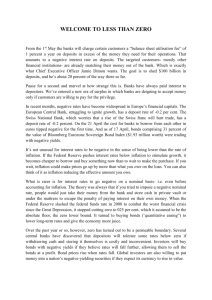CHAPTER OVERVIEW
advertisement
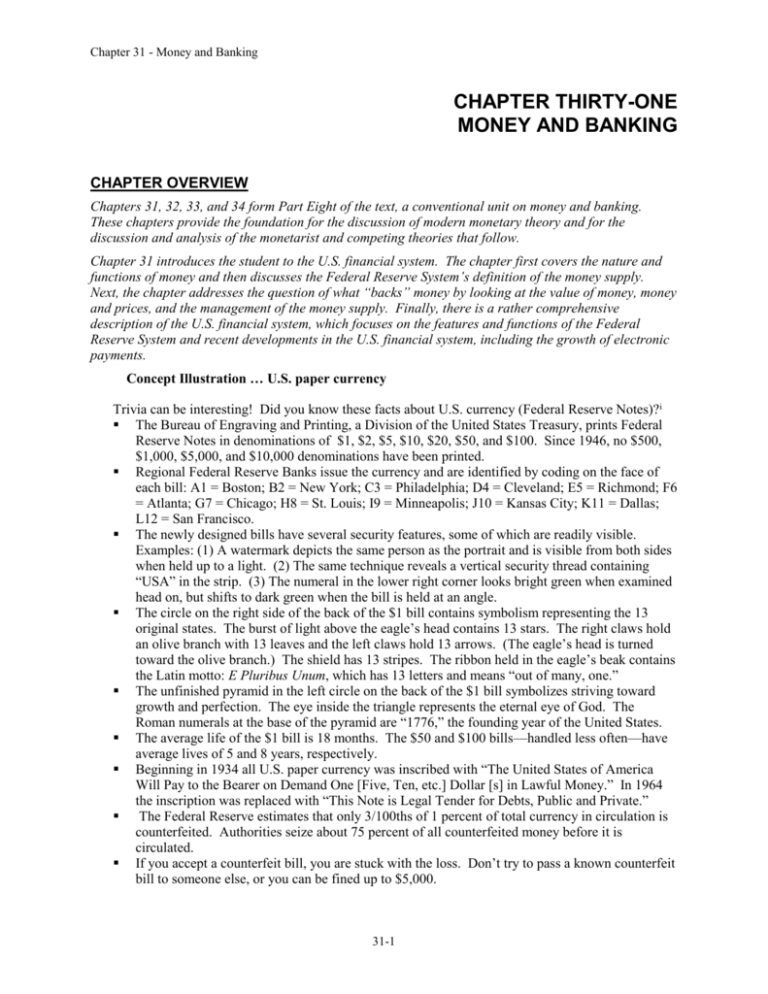
Chapter 31 - Money and Banking CHAPTER THIRTY-ONE MONEY AND BANKING CHAPTER OVERVIEW Chapters 31, 32, 33, and 34 form Part Eight of the text, a conventional unit on money and banking. These chapters provide the foundation for the discussion of modern monetary theory and for the discussion and analysis of the monetarist and competing theories that follow. Chapter 31 introduces the student to the U.S. financial system. The chapter first covers the nature and functions of money and then discusses the Federal Reserve System’s definition of the money supply. Next, the chapter addresses the question of what “backs” money by looking at the value of money, money and prices, and the management of the money supply. Finally, there is a rather comprehensive description of the U.S. financial system, which focuses on the features and functions of the Federal Reserve System and recent developments in the U.S. financial system, including the growth of electronic payments. Concept Illustration … U.S. paper currency Trivia can be interesting! Did you know these facts about U.S. currency (Federal Reserve Notes)?i The Bureau of Engraving and Printing, a Division of the United States Treasury, prints Federal Reserve Notes in denominations of $1, $2, $5, $10, $20, $50, and $100. Since 1946, no $500, $1,000, $5,000, and $10,000 denominations have been printed. Regional Federal Reserve Banks issue the currency and are identified by coding on the face of each bill: A1 = Boston; B2 = New York; C3 = Philadelphia; D4 = Cleveland; E5 = Richmond; F6 = Atlanta; G7 = Chicago; H8 = St. Louis; I9 = Minneapolis; J10 = Kansas City; K11 = Dallas; L12 = San Francisco. The newly designed bills have several security features, some of which are readily visible. Examples: (1) A watermark depicts the same person as the portrait and is visible from both sides when held up to a light. (2) The same technique reveals a vertical security thread containing “USA” in the strip. (3) The numeral in the lower right corner looks bright green when examined head on, but shifts to dark green when the bill is held at an angle. The circle on the right side of the back of the $1 bill contains symbolism representing the 13 original states. The burst of light above the eagle’s head contains 13 stars. The right claws hold an olive branch with 13 leaves and the left claws hold 13 arrows. (The eagle’s head is turned toward the olive branch.) The shield has 13 stripes. The ribbon held in the eagle’s beak contains the Latin motto: E Pluribus Unum, which has 13 letters and means “out of many, one.” The unfinished pyramid in the left circle on the back of the $1 bill symbolizes striving toward growth and perfection. The eye inside the triangle represents the eternal eye of God. The Roman numerals at the base of the pyramid are “1776,” the founding year of the United States. The average life of the $1 bill is 18 months. The $50 and $100 bills—handled less often—have average lives of 5 and 8 years, respectively. Beginning in 1934 all U.S. paper currency was inscribed with “The United States of America Will Pay to the Bearer on Demand One [Five, Ten, etc.] Dollar [s] in Lawful Money.” In 1964 the inscription was replaced with “This Note is Legal Tender for Debts, Public and Private.” The Federal Reserve estimates that only 3/100ths of 1 percent of total currency in circulation is counterfeited. Authorities seize about 75 percent of all counterfeited money before it is circulated. If you accept a counterfeit bill, you are stuck with the loss. Don’t try to pass a known counterfeit bill to someone else, or you can be fined up to $5,000. 31-1 Chapter 31 - Money and Banking As long as you present what is clearly more than one-half a bill, a bank will accept it for deposit or replace it. The bank then sends the bill to a Federal Reserve Bank, which destroys it and issues another bill in its place. Source: Federal Reserve System, “Fundamental Facts about U. S. Money,” 1998. NOTES I. Learning objectives – In this chapter students will learn: A. About the functions of money and the components of the U.S. money supply. B. What “backs” the money supply, making us willing to accept it as payment. C. The makeup of the Federal Reserve and the U.S. banking system. D. The functions and responsibilities of the Federal Reserve. II. Functions of Money A. Medium of exchange: Money can be used for buying and selling goods and services. B. Unit of account: Prices are quoted in dollars and cents. C. Store of value: Money allows us to transfer purchasing power from present to future. It is the most liquid (spendable) of all assets, a convenient way to store wealth. III. Components of the Money Supply A. Narrow definition of money: M1 includes currency and checkable deposits (see Figure 31.1a). 1. Currency (coins + paper money) held by public. (56% of M1) a. Is “token” money, which means its intrinsic value is less than actual value. The metal in a dime is worth less than 10¢. b. All paper currency consists of Federal Reserve Notes issued by the Federal Reserve. 2. Checkable deposits are included in M1, since they can be spent almost as readily as currency and can easily be changed into currency. (44% of M1) a. Commercial banks are a main source of checkable deposits for households and businesses. b. Thrift institutions (savings & loans, credit unions, mutual savings banks) also have checkable deposits. 3. Qualification: Currency and checkable deposits held by the federal government, Federal Reserve, or other financial institutions are not included in M1. B. Money Definition: M2 = M1 + some near-monies which include: (See Figure 31.1b) 1. Savings deposits and money market deposit accounts. 2. Small time deposits (certificates of deposit) less than $100,000. 3. Money market mutual fund balances, which can be redeemed by phone calls, checks, or through the Internet. C. CONSIDER THIS … Are Credit Cards Money? Credit cards are not money, but their use involves short-term loans; their convenience allows you to keep M1 balances low because you need less for daily purchases. 31-2 Chapter 31 - Money and Banking IV. What “backs” the money supply? A. The government’s ability to keep its value stable provides the backing. B. Money is debt; paper money is a debt of Federal Reserve Banks and checkable deposits are liabilities of banks and thrifts because depositors own them. C. Value of money arises not from its intrinsic value, but its value in exchange for goods and services. 1. It is acceptable as a medium of exchange. 2. Currency is legal tender or fiat money. In general, it must be accepted in repayment of debt, but that doesn’t mean that private firms and government are mandated to accept cash; alternative means of payment may be required. (Note that checks are not legal tender but, in fact, are generally acceptable in exchange for goods, services, and resources. Legal cases have essentially determined that pennies are not legal tender.) 3. The relative scarcity of money compared to goods and services will allow money to retain its purchasing power. D. Money’s purchasing power determines its value. Higher prices mean less purchasing power. (Key Question #6) E. Excessive inflation may make money worthless and unacceptable. An extreme example of this was German hyperinflation after World War I, which made the mark worth less than 1 billionth of its former value within a four-year period. 1. Worthless money leads to use of other currencies that are more stable. 2. Worthless money may lead to barter exchange system. F. Maintaining the value of money 1. The government tries to keep supply stable with appropriate fiscal policy. 2. Monetary policy tries to keep money relatively scarce to maintain its purchasing power, while expanding enough to allow the economy to grow. V. The Federal Reserve and the Banking System A. The Federal Reserve System (the “Fed”) was established by Congress in 1913 and holds power over the money and banking system. 1. Figure 31.2 gives framework of Fed and its relationship to the public. 2. The central controlling authority for the system is the Board of Governors and has seven members appointed by the President for staggered 14-year terms. Its power means the system operates like a central bank. 3. The Federal Open Market Committee (FOMC) includes the seven governors plus five regional Federal Reserve Bank presidents whose terms alternate. They set policy on buying and selling of government bonds, the most important type of monetary policy, and meet several times each year. 4. The system has twelve districts, each with its own district bank and two or three branch banks. They help implement Fed policy and are advisory. (See Figure 31.3) a. Each is quasi-public: It is owned by member banks but controlled by the government’s Federal Reserve Board, and any profits go to the U.S. Treasury. 31-3 Chapter 31 - Money and Banking b. They act as bankers’ banks by accepting reserve deposits and making loans to banks and other financial institutions. In making loans, the Federal Reserve is the “lender of last resort,” meaning that the Fed is available to lend money should other avenues (e.g. other commercial banks) not be available. 3. About 7,600 commercial banks existed in 2006. They are privately owned and consist of state banks (three-fourths of total) and large national banks (chartered by the Federal government). 4. Thrift institutions consist of savings and loan associations, credit unions, and mutual savings banks. They are regulated by the Treasury Dept. Office of Thrift Supervision, but they may use services of the Fed and keep reserves on deposit at the Fed. Of the approximately 11,400 thrift institutions, most are credit unions. 5. Global Perspective 31.1 gives the world’s twelve largest financial institutions. B. Functions of the Fed and money supply: 1. The Fed issues “Federal Reserve Notes,” the paper currency used in the U.S. monetary system. 2. The Fed sets reserve requirements and holds the reserves of banks and thrifts not held as vault cash. 3. The Fed may lend money to banks and thrifts, charging them an interest rate called the discount rate. 4. The Fed provides a check collection service for banks (checks are also cleared locally or by private clearing firms). 5. Federal Reserve System acts as the fiscal agent for the Federal government. 6. The Federal Reserve System supervises member banks. 7. Monetary policy and control of the money supply is the “major function” of the Fed. C. Federal Reserve independence is important but is also controversial from time to time. Advocates of independence fear that more political ties would cause the Fed to follow expansionary policies and create too much inflation, leading to an unstable currency such as that in other countries (see Last Word for this chapter). VI. Recent Developments in Money and Banking A. Relative decline of banks and thrifts: Several other types of firms offer financial services. B. Consolidation among banks and thrifts: Because of failures and mergers, there are fewer banks and thrifts today. Since 1990, there has been a decline of 5200 banks. C. Convergence of services provided has made financial institutions more similar: See text on new laws of 1996 and 1999 that made many changes possible. D. Globalization of financial markets: Significant integration of world financial markets is occurring and recent advances in computer and communications technology suggest the trend is likely to accelerate. E. Electronic payments: Internet buying and selling (including PayPal), Fedwire transfers, and “smart cards” are examples. In the future, nearly all payments could be made with a personal computer or “smart card.” 31-4 Chapter 31 - Money and Banking VII. LAST WORD: The Global Greenback A. An estimated $450 billion of U.S. currency is circulating abroad. 1. $450 billion is about 60% of the total U.S. currency held by the public. 2. Russians hold about $80 billion because dollar value is stable, however recently some Russians have transferred their holdings to euros. 3. Argentina holds $50 billion and fixes its own peso exchange rate to dollar reserves. B. U.S. profits when dollars stay overseas: It costs us 4¢ to print each dollar and to get the dollar; foreigners must sell Americans $1 worth of products. Americans gain 96¢ over cost of printing the dollar. It’s like someone buying a traveler’s check and never cashing it. C. Black markets and illegal activity overseas also are usually conducted in dollars because they are such a stable form of currency. D. Overall, the “global greenback” is a positive economic force. It is a reliable medium of exchange, measure, and store of value that facilitates transactions everywhere and there is little danger that all the dollars will return to U.S. ANSWERS TO END-OF-CHAPTER QUESTIONS 31-1 What are the three basic functions of money? Describe how rapid inflation can undermine money’s ability to perform each of the three functions. Money is used as a medium of exchange for goods and services, as a unit of account for expressing price, and as a store of value. People will only accept money in exchange for goods and services and for the work they perform if they can be reasonably certain that the medium of exchange—money—will retain its value until they are ready to spend it. In runaway inflations of the thousands or tens of thousands of percent a year, people revert to barter. Again, drastic inflation greatly reduces money’s use as a measure of value, for it is impossible to adjust instantaneously all prices strictly in line with their relative values. Thus, opportunities are afforded to speculators to profit at the expense of the less sophisticated who, eventually, will learn to distrust money’s usefulness as a measure of value. Finally, and most obviously, money’s usefulness as a store of value is destroyed in a drastic inflation. The “rule of 70” is instructive here. By dividing the absolute inflation rate into 70, one can estimate how long it takes one’s dollar savings to lose half their purchasing power. At 7 percent inflation, the dollar will be worth half as much in ten years. 31-2 Which two of the following financial institutions offer checkable deposits included within the M1 money supply: mutual fund companies; insurance companies; commercial banks; securities firms; thrift institutions? Which of the following is not included in either M1 or M2: currency held by the public; checkable deposits, money market mutual fund balances; small (less than $100,000) time deposits; currency held by banks; savings deposits? Commercial banks and thrift institutions offer checkable deposits. Currency held by banks is not counted in either M1 or M2. 31-5 Chapter 31 - Money and Banking 31-3 Explain and evaluate the following statements: a. The invention of money is one of the great achievements of humankind, for without it the enrichment that comes from broadening trade would have been impossible. b. Money is whatever society says it is. c. In most economies of the world, the debts of government and commercial banks are used as money. d. People often say they would like to have more money, but what they usually mean is that they would like to have more goods and services. e. When the price of everything goes up, it is not because everything is worth more but because the currency is worth less. f. Any central bank can create money; the trick is to create enough, but not too much, of it. (a) Without money, trade must occur through barter. Barter requires the “double coincidence of wants,” the requirement that a seller find a buyer who not only desires what the seller has to offer but also has to offer what the buyer desires. A wheat farmer desiring milk must find a dairy farmer desiring wheat or, at least, a merchant in the middle trading in both wheat and milk. Maybe one can imagine a merchant owning both a grain elevator and refrigerated milk holding tanks. But suppose the wheat farmer desires a new suit or a new combine? So far all we have been talking about is local trade. Suppose the dairy farmer desires oriental spices, to use an example from the beginning of trade after the ending of the Dark Ages in Europe. The dairy farmer could hardly ship the milk to the Orient, so a buyer must be found in Europe who desires milk and who has something our dairy farmer can trade for oriental spices. And how are the terms of trade to be determined in the absence of money? Is a quart of milk worth an ounce of pepper? Or how much of what the dairy farmer got locally for milk is worth an ounce of pepper? As one can see, without a measure of value the complications are enormous. (b) Money must be acceptable in exchange. That is its fundamental requirement. A person will accept payment in whatever is called money only if that person knows that the money can subsequently be used in exchange for something else. If the money is easily, cheaply predicable by a monetary authority, it will only be acceptable if the conviction exists that the authority will keep the rate of increase below the hyperinflationary level. If the money is a commodity such as cigarettes in a prisoner-of-war camp, the commodity will be acceptable as money not only because of its intrinsic value, but also, again, because there is no fear of the supply suddenly increasing to a hyperinflationary level. Note that checks are our primary medium of exchange, although they have not been deemed legal tender by government. (c) All accounts (saving and checking) in the commercial banks are money owed by these banks to their customers, who own these deposits. Since checks drawn on checking accounts are accepted as money (since they demand payment out of these checking accounts), it follows that the debts of the commercial banks are used as moneys. Paper money is merely the circulating debt of the government. 31-6 Chapter 31 - Money and Banking (d) People often use the term “money” when they are referring to wealth or income. Wealth refers to accumulated assets, measured at a point in time. Money is an asset, and can be used as a store of value. However, holding wealth in the form of money provides no creature comforts, nor does it return much additional income (before interest was paid on checking balances, the return was zero). Money is also a unit of account, a means of measurement, literally a yardstick that is used for comparison purposes. When people say they want more money, they are saying they want to be richer—to have more things. (e) The statement is accurate. If the price of one thing goes up relative to another, it is fair to claim that it has become more valuable, but if the price of everything rises, it means that the currency has less purchasing power (i.e. is worth less). (f) The most important function of the Federal Reserve (or any central bank) is to manage the nation’s money supply and thus interest rates. This involves making an amount of money available that is consistent with high and rising levels of output and employment and a relatively constant price level. 31-4 (Key Question) What are the components of the M1 money supply? What is the largest component? Which of the components of M1 is legal tender? Why is the face value of a coin greater than its intrinsic value? What near-monies are included in M2 money supply? M1 = currency (in circulation) + checkable deposits. The largest component of M1 is currency (54 percent), and it is the only part that is legal tender. If the face value of a coin were not greater than its intrinsic (metallic) value, people would remove coins from circulation and sell them for their metallic content. M2 = M1 + noncheckable savings deposits + money market deposit accounts + small time deposits + money market mutual fund balances. 31-5 What “backs” the money supply in the United States? What determines the value (domestic purchasing power) of money? How does the purchasing power of money relate to the price level? Who is the U.S. is responsible for maintaining money’s purchasing power? There is no concrete backing to the money supply in the United States. Paper money, which has no intrinsic value, has value only because people are willing to accept it in exchange for goods and services, including their labor services as employees. And people are willing to accept paper as money because they know that everyone else is also willing to do so. If the monetary authorities were issuing new banknotes at a rate far in excess of available output, the acceptability of paper money would diminish. People would start to worry about whether the banknotes would be worth much after they received them. Checks are part of the money supply and are not legal tender, but people accept them willingly from people believed trustworthy. The purchasing power of money is inversely related to the price level. The Board of Governors of the Federal Reserve System (the Fed) is responsible for managing the United States’ money supply so that money retains its purchasing power. 31-6 (Key Question) Suppose the price level and value of the dollar in year 1 are 1.0 and $1.00, respectively. If the price level rises to 1.25 in year 2, what is the new value of the dollar? If instead the price level had fallen to .50, what would have been the value of the dollar? What generalization can you draw from your answer? In the first case, the value of the dollar (in year 2, relative to year 1) is $.80 (= 1/1.25); in the second case the value is $2 (= 1/.50). Generalization: The price level and the value of the dollar are inversely related. 31-7 Chapter 31 - Money and Banking 31-7 How is the chairperson of the Federal Reserve Board selected? Describe the relationship between the Board of Governors of the Federal Reserve System and the 12 Federal Reserve Banks. What are the composition and purpose of the Federal Open Market Committee (FOMC)? The members of the Board of Governors of the Federal Reserve are selected by the U.S. president and confirmed by the Senate. The seven board members have long terms—14 years— and staggered so that one member is replaced every 2 years. The president selects the chairperson and vice-chairperson of the board from among the members, and they serve 4-year terms. Several entities assist the Board of Governors in determining banking and monetary policy. The Federal Open Market Committee is the most important, voting on the Fed’s monetary policy and directing the purchase or sale of government securities. Five of the presidents of the Federal Reserve Banks have voting rights on the FOMC each year, rotating the membership among the 12 banks, except for the president of the NY Fed who has a permanent voting seat. 31-8 (Key Question) What is meant when economists say that the Federal Reserve Banks are central banks, quasi-public banks, and bankers’ banks? What are the seven basic functions of the Federal Reserve System? The 12 Federal Reserve Banks are “central” banks whose policies are coordinated by the Board of Governors. They are quasi-public banks, meaning that they are a blend of private ownership and public control. They are also bankers’ banks in that they perform essentially the same functions for banks and thrifts as those institutions perform for the public. The Federal Reserve performs 7 basic functions: 1. The Fed issues Federal Reserve Notes, the paper currency used in the U.S. monetary system. 2. The Fed sets reserve requirements and holds the mandated reserves that are not held as vault cash. 3. The Fed lends money to banks and thrifts. 4. The Fed provides for check collection. 5. The Fed acts as fiscal agent for the Federal government. 6. The Fed supervises the operation of banks. 7. Finally, and most importantly, the Fed has responsibility for regulating the supply of money, and this in turn enables it to affect interest rates. 31-9 Following are two hypothetical ways in which the Federal Reserve Board might be appointed. Would you favor either of these two methods over the present method? Why or why not? a. Upon taking office, the U.S. President appoints 7 people to the Federal Reserve Board, including a chair. Each appointee must be confirmed by a majority vote of the Senate, and each serves the same 4-year term as the president. b. Congress selects 7 members from its ranks (4 from the House of Representatives and 3 from the Senate) to serve as its pleasure as the Board of Governors of the Federal Reserve System. In the opinion of most economists, the Fed should be protected from political pressures so that it can effectively control the money supply and maintain price stability. Option (a) would create a Board of Governors that sat at the pleasure of the president, placing the monetary policy of the country in the hands of the executive branch. Option (b) would place the BOG under the control of Congress. Neither of the options would maintain the independence needed for effective monetary policy. 31-8 Chapter 31 - Money and Banking 31-10 What are the major categories of firms that make up the U.S. financial services industry? Did the bank and thrift share of the financial services market rise, fall, or stay the same between 1980 and 2007? Are there more or fewer bank firms today than a decade ago? Why are the lines between the categories of financial firms becoming more blurred than in the past? The major categories of firms that make up the U.S. financial services industry include: commercial banks, thrifts, insurance companies, mutual fund companies, pension funds, and securities related firms. Commercial banks and thrifts have declined in market share substantially since 1980. In response they have offered a variety of new services, purchased or merged with other institutions, and pushed Congress for regulatory reform. 31-11 How does a debit card differ from a credit card? How does a stored-value card differ from both? Suppose that a person has a credit card, debit card, and stored-value card. Create a fictional scenario in which the person uses all three cards in the same day. Explain the person’s logic for using one card rather than one of the others for each transaction. How do Fedwire and ACH transactions differ from credit card, debit card, and stored-value card transactions? Debit cards access a financial asset – a checkable deposit; credit cards incur a liability – credit card holders take out a loan whenever they use the credit card for purchases. A stored-value card keeps the money on the card, stored in a memory chip, rather than providing access to an account or a loan sited elsewhere. Fictional scenario: Alex pays for airplane tickets with a credit card, preferring the short-term loan for the large purchase, perhaps waiting until the next pay period to pay his balance. Alex then buys groceries using a debit card; there is enough in his checking account to cover the transaction and he doesn’t like to take out loans (i.e. use a credit card) to fund current consumption. Alex pays for his soy hot chocolate at Starbucks using a stored-value card. The card, a gift from his grandparents, is only usable at Starbucks. If he loses his stored-value card he only loses the balance on the card; losing a debit or credit card can be more costly if whomever finds (or took) the card spends until the account is drained or the spending limit is reached. Fedwire transfers are used to transfer funds between banks. Individuals, businesses, and banks can arrange transfers between financial institutions. ACH transactions are used frequently to make recurring payments (automatic bill payments – mortgages, utilities, insurance premiums, etc.). Returning to our fictional scenario, Alex might pay his mortgage with using an ACH, and may use a Fedwire transfer to move money from a mutual fund to his checking account in order to pay off his credit card bill. 31-12 (Last Word) Over the years, the Federal Reserve Banks have printed many billions of dollars more in currency than American households, businesses, and financial institutions now hold. Where is this “missing” money? Why is it there? This missing money is outside of the country. It originally left the country to pay for imports of goods and services purchased by Americans from producers abroad. Now it is in circulation outside the country, especially in countries whose currencies are not very stable. For example, it is estimated that Russians hold about $80 billion worth of U.S. dollars. Transactions are conducted in dollars inside Russia, because Russians fear that when they accept the Russian ruble, it may lose its purchasing power very quickly. The same is true in other countries with high rates of inflation. The dollar is also used in international transactions, both legal and illegal, where it is acceptable because of its stability. 31-9

